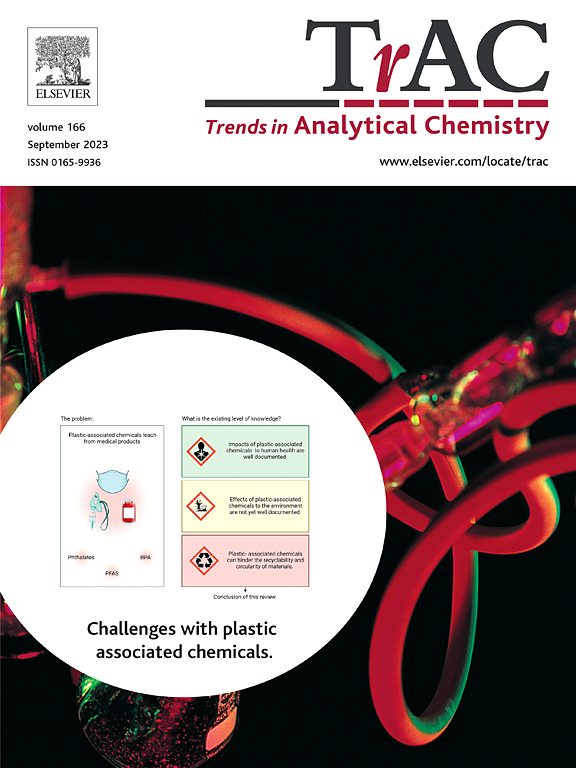Fluorescent nanozymes: Emerging versatile materials advancing analytical chemistry
IF 11.8
1区 化学
Q1 CHEMISTRY, ANALYTICAL
引用次数: 0
Abstract
Since the revelation of Fe3O4 nanoparticles with enzyme-like characteristics, nanozymes present a promising alternative to traditional bio-enzymes due to their straightforward preparation, good robustness, and adjustable performance. In addition to enzyme-mimetic catalysis, these materials also tend to show optical, electrical, thermal, and magnetic properties. Integrating nanozyme catalysis with these properties into an entity can offer fascinating merits to biochemical sensing. Especially, fluorescent nanozymes, a class of materials combining enzyme-mimicking activity and fluorescence, have been drawing growing interest in the analytical chemistry community in the past five years. To highlight the achievements and progress made in this emerging area, here we, for the first time, present a comprehensive summary on fluorescent nanozymes and their roles in advancing analytical detection. First, a definition of fluorescent nanozymes is given, and their bifunctional features are discussed. Then, common strategies employed to develop different material types of fluorescent nanozymes are introduced. Emphatically, their unique contributions to biochemical analysis are clarified in detail, along with various applications in environmental monitoring, food safety analysis, and biomedical detection. Finally, substantial potential of fluorescent nanozymes in realizing advanced detection as well as existing challenges is spotlighted. Our review provides a comprehensive and up-to-date reference on fluorescent nanozymes, which will attract more attention and guide future efforts to further promote the promising field.

荧光纳米酶:推动分析化学发展的新兴多功能材料
自从具有酶样特性的Fe3O4纳米颗粒被发现以来,纳米酶因其制备简单、鲁棒性好和可调节的性能而成为传统生物酶的一个有希望的替代品。除了模拟酶的催化作用外,这些材料还具有光学、电学、热学和磁性。将具有这些特性的纳米酶催化整合到一个实体中可以为生化传感提供令人着迷的优点。特别是荧光纳米酶,一类结合了酶模拟活性和荧光的材料,在过去的五年中引起了分析化学界越来越多的兴趣。为了突出这一新兴领域的成就和进展,我们首次对荧光纳米酶及其在推进分析检测方面的作用进行了全面的总结。首先,给出了荧光纳米酶的定义,并讨论了它们的双功能特征。然后,介绍了开发不同材料类型荧光纳米酶的常用策略。重点阐述了它们对生化分析的独特贡献,以及在环境监测、食品安全分析和生物医学检测中的各种应用。最后,强调了荧光纳米酶在实现先进检测方面的巨大潜力以及存在的挑战。本文综述了荧光纳米酶的最新研究进展,以期引起人们的重视,并指导今后进一步发展这一具有广阔前景的领域。
本文章由计算机程序翻译,如有差异,请以英文原文为准。
求助全文
约1分钟内获得全文
求助全文
来源期刊

Trends in Analytical Chemistry
化学-分析化学
CiteScore
20.00
自引率
4.60%
发文量
257
审稿时长
3.4 months
期刊介绍:
TrAC publishes succinct and critical overviews of recent advancements in analytical chemistry, designed to assist analytical chemists and other users of analytical techniques. These reviews offer excellent, up-to-date, and timely coverage of various topics within analytical chemistry. Encompassing areas such as analytical instrumentation, biomedical analysis, biomolecular analysis, biosensors, chemical analysis, chemometrics, clinical chemistry, drug discovery, environmental analysis and monitoring, food analysis, forensic science, laboratory automation, materials science, metabolomics, pesticide-residue analysis, pharmaceutical analysis, proteomics, surface science, and water analysis and monitoring, these critical reviews provide comprehensive insights for practitioners in the field.
 求助内容:
求助内容: 应助结果提醒方式:
应助结果提醒方式:


